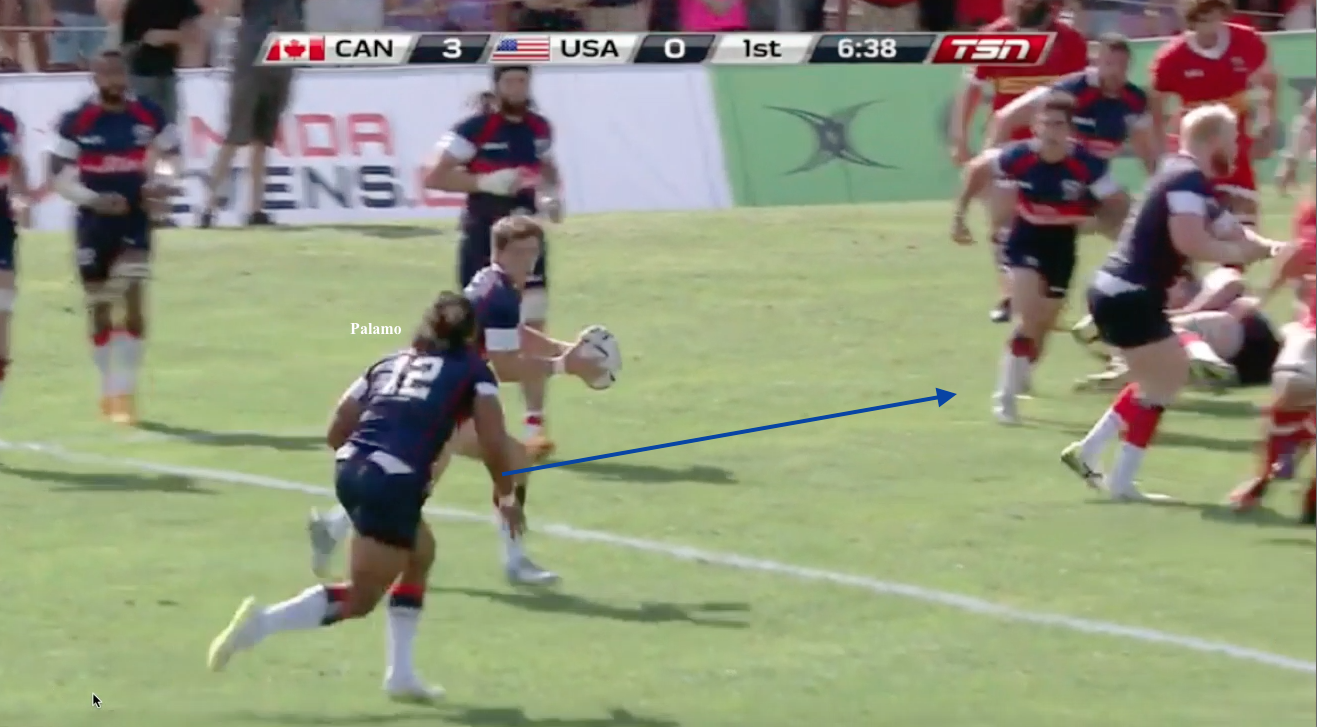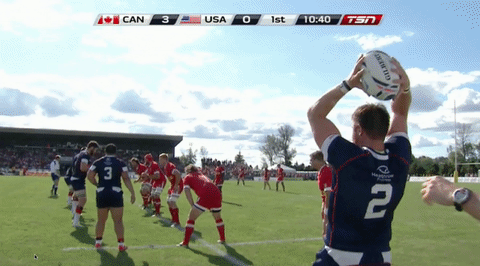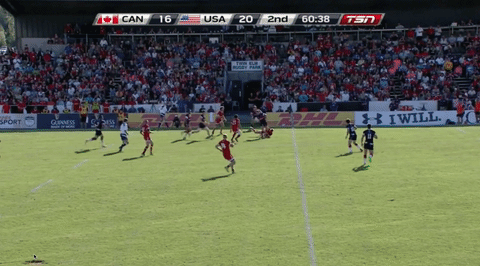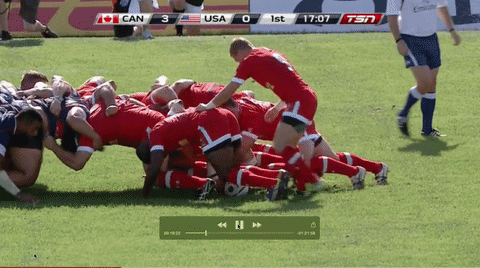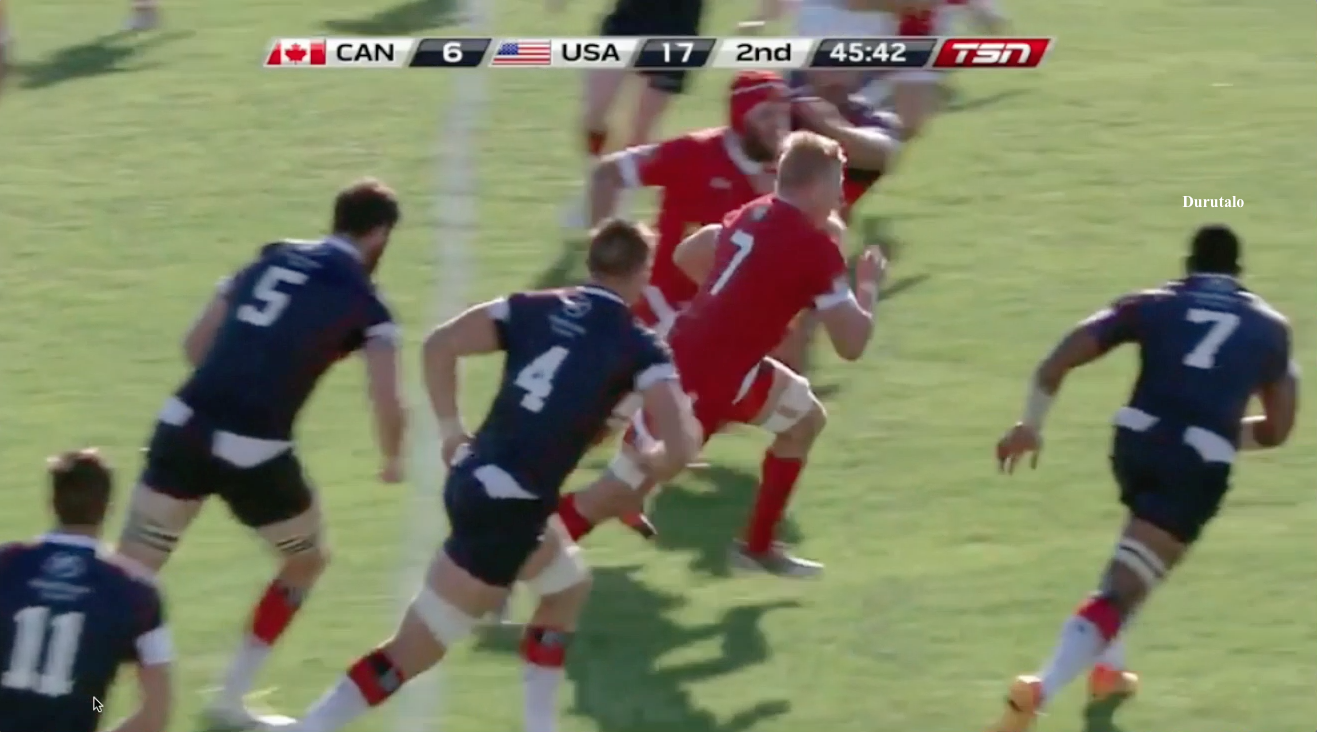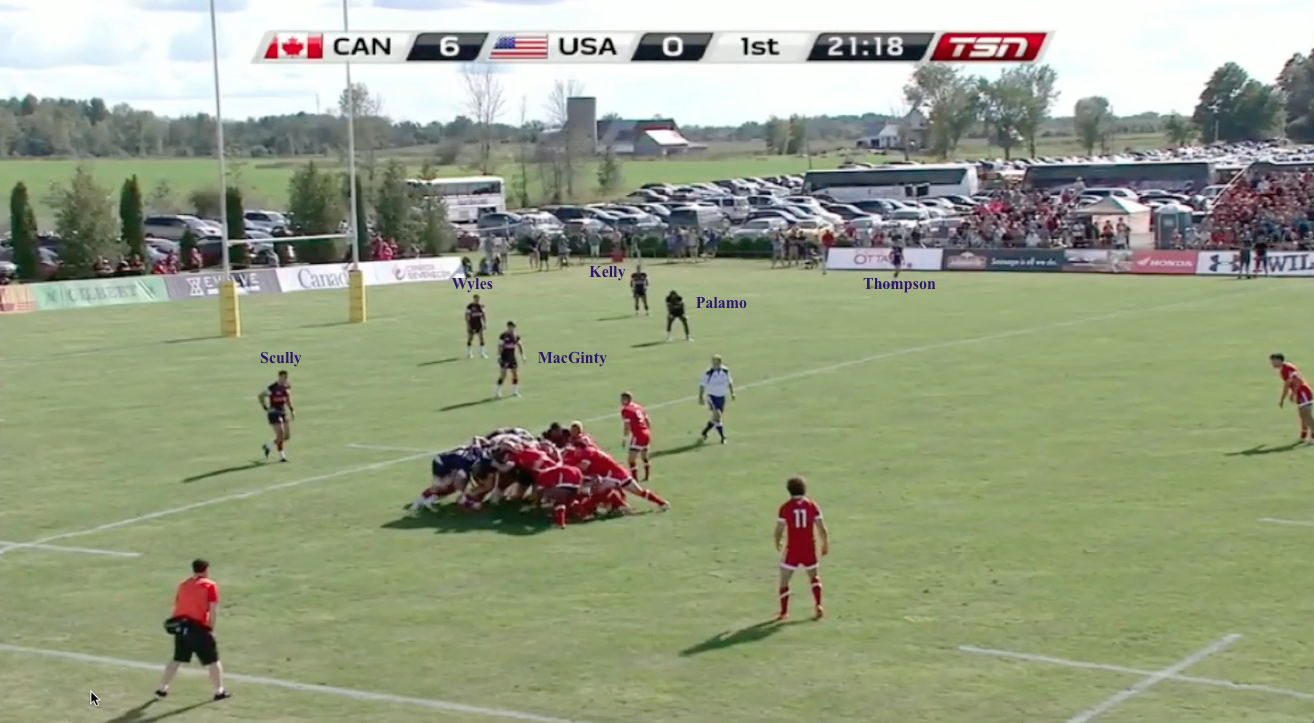
PHILADELPHIA, PA – By the final scoreline, it looks as though the Eagles handled Canada pretty easily last Saturday. The 41-23 result was, largely, what the Eagles needed and what the Canadians must have been fearing. But, for both sides, the match must be viewed both in terms of what happened on the day and what it portends for the World Cup.
Looking at the match from the Canadian perspective, they aren’t going to beat many teams playing that way. Still, the game was 20-16 with about 11 minutes remaining. Canada was on the attack with 15 minutes remaining when Phil Mack was given a yellow card for stamping. The stamp occurred while Canada was playing under a penalty advantage, so they went from having a good chance to pull within one (from the penalty goal), to being down a player. The USA scored 14 points while Mack was out, including a try by the opposite scrum half, Mike Petri.
Without a doubt, those were the key 10 minutes of the match, but let’s take a look at some of the other details.
Poor American Start
It was not a good opening 15 minutes or so for the Eagles.
Canada kicked several restarts to Danny Barrett inside the 22. The first two times he was tackled by one player. In the first tackle, John Phelan was able to get back to his feet before Mike Petri started the next phase. That means that Canada had 15 defenders on their feet and ready when Petri made the first pass of the game.
Petri’s pass went to Andrew Durutalo who also only committed one tackler. Petri’s subsequent box kick went 13 meters. Canada had the chance to win the ball about 35 meters from the USA try line. Not, one suspects, what was hoped for.
However, Blaine Scully contested the kick and a Canadian knocked the ball on. Under advantage, there is another crash ball and Petri goes for another box kick. This one goes deeper, but the Eagles defensive line is less prepared. Taylor Paris gets past Durutalo and Greg Peterson and then bumps off Titi Lamositele who was joining the defensive line late.
On the next phase, Nick Blevins hands off Al MacFarland and the Canadians are truly on the front foot. When Canada move the ball to the other side of the field quickly, they have a real chance for a try and end up winning a penalty inside their attacking 22.
The Canadians kick to touch. Eric Fry ends the maul from the lineout legally, but the Eagles were offside on the next phase. This time, from a slightly more central position, Gordon McRorie took that shot at posts. 3-0 Canada.
The Canadian chances early did not stop there, but they failed to convert those chances into any early tries.
The USA Tries
For a neutral, I suspect Peterson’s try looked pretty boring, but from an American supporter’s point of view it was drool-inducing.
First, the scrum was not only won, but there was a real shove. Barrett showed some patience at the base of the scrum, and when he went, Palamo was ready to come in and support from the centers. The ball was produced quickly enough and Peterson was ready for the pass coming around the corner of the ruck, with MacFarland in support, and looked strong in getting over the line.
The performance of the scrum is excellent, of course, but so too is the fact that the players seemed to have the same understanding about what was going to happen and what their roles were.
Andrew Durutalo’s try was also connected to a solid scrum providing a good attacking platform. Here is how it started.
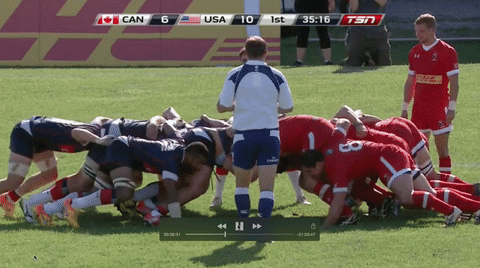 It looked like the chance was gone when Wyles’ chip went awry. Good luck and good hustle (Mike Petri and AJ MacGinty there to pressure the Canadian trying to field the ball) saved it.
It looked like the chance was gone when Wyles’ chip went awry. Good luck and good hustle (Mike Petri and AJ MacGinty there to pressure the Canadian trying to field the ball) saved it.
The third USA try started from turnover ball deep in their own half. A Wyles break and a Petri chip put the Eagles in a good position.
More important, though is the fact that when the Canadians fielded the ball, they were tackled inside the 22 because of the strong effort of the Eagles to apply pressure.
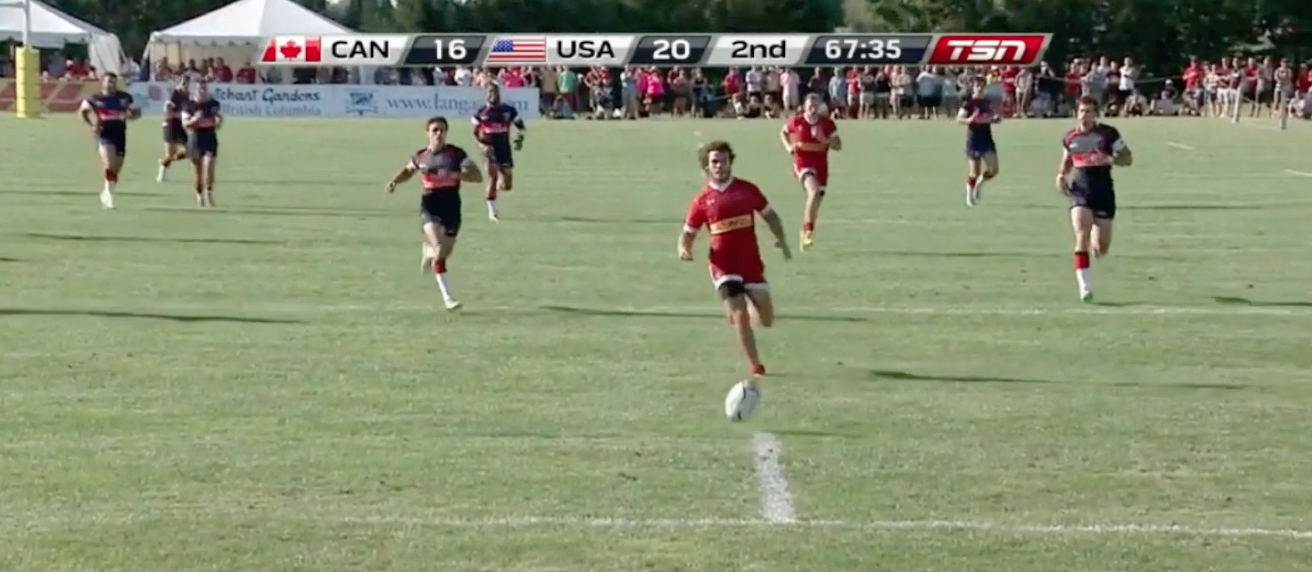 On one side of Petri was Brett Thompson; on the other side was Phil Thiel.
On one side of Petri was Brett Thompson; on the other side was Phil Thiel. 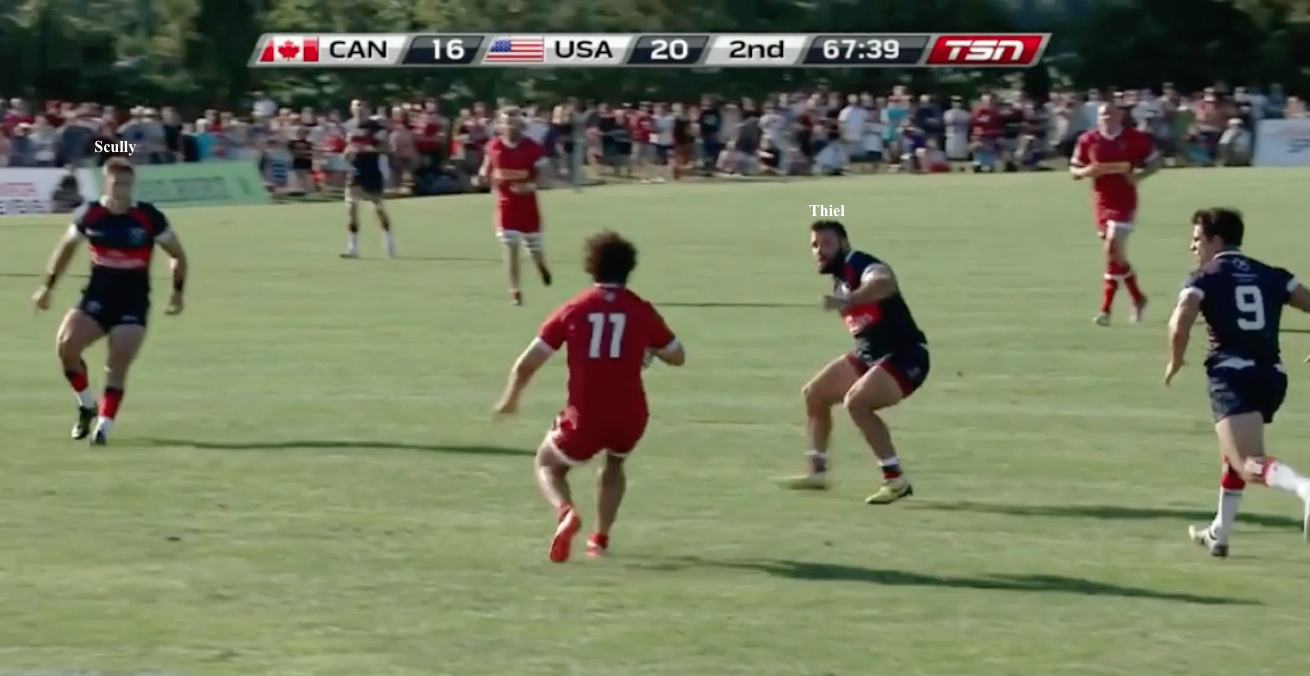 Thiel pushed Paris toward Blaine Scully who, along with Al McFarland, made the tackle.
Thiel pushed Paris toward Blaine Scully who, along with Al McFarland, made the tackle.
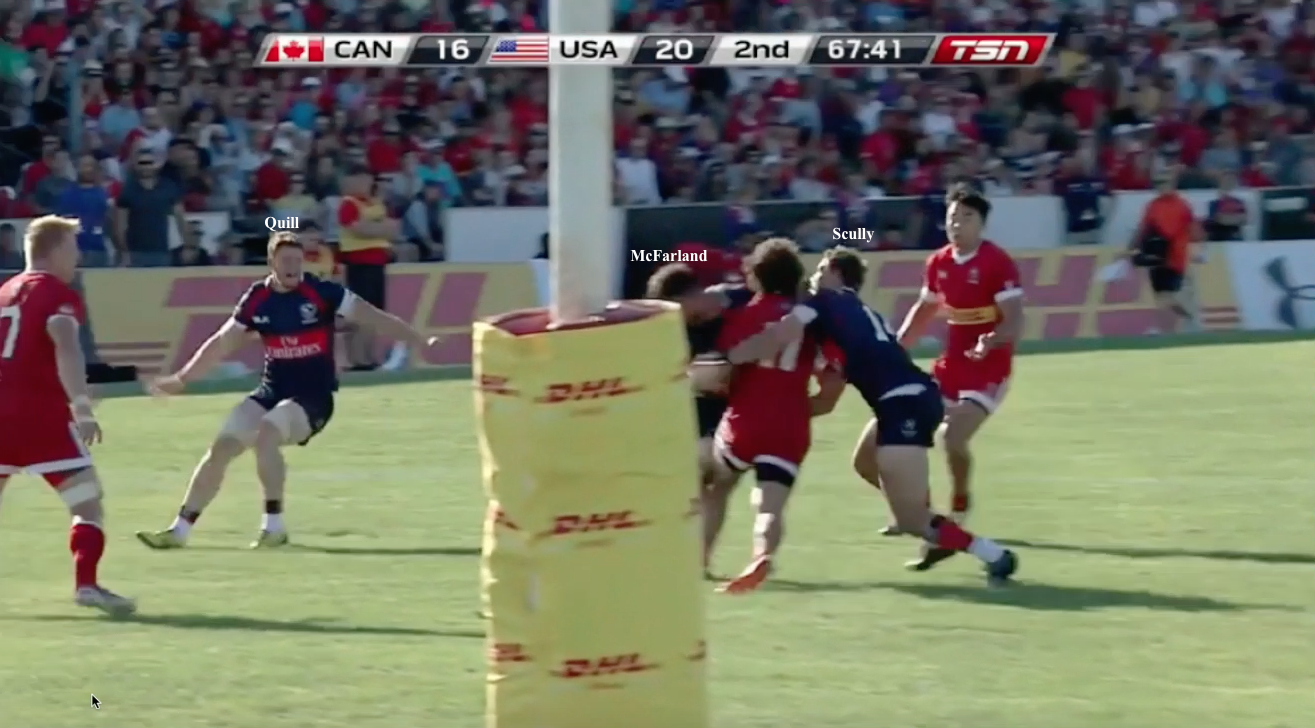 After the Canadians kicked, MacGinty passed to Wyles who made another break and kept the Canadians scrambling.
After the Canadians kicked, MacGinty passed to Wyles who made another break and kept the Canadians scrambling.
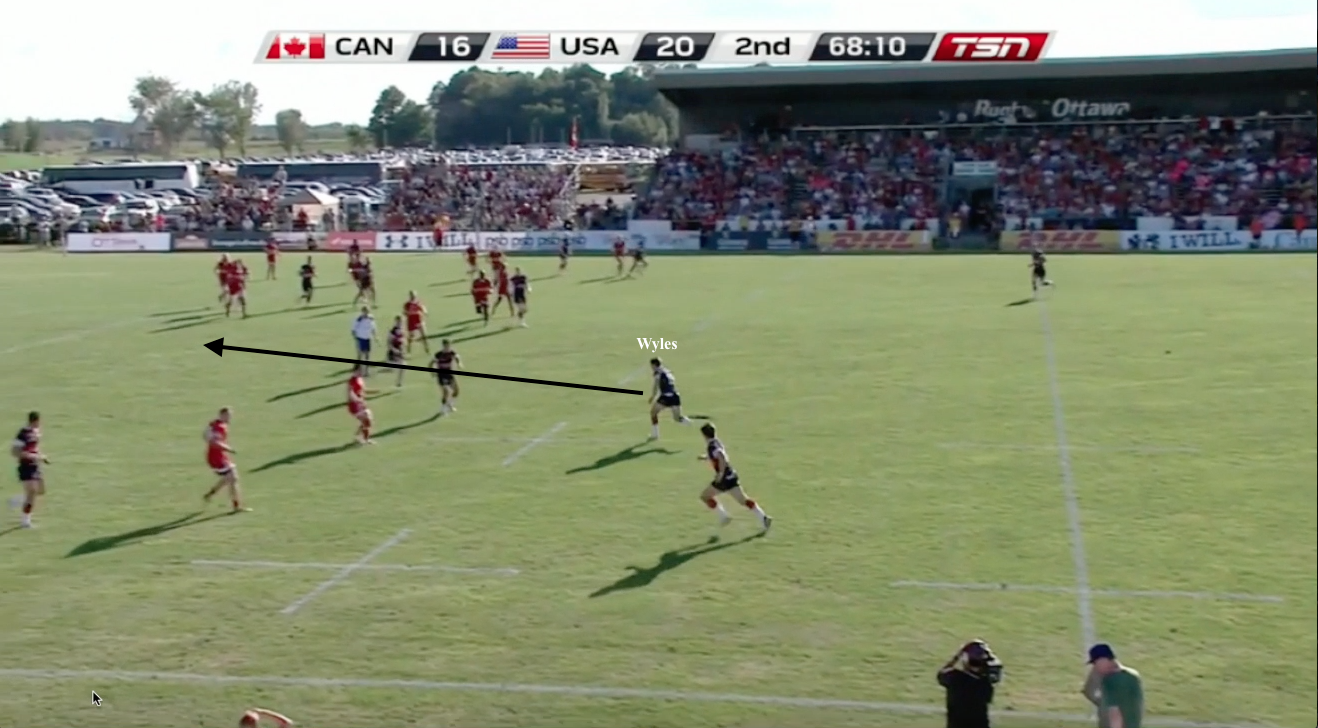 After Wyles’ break, the Eagles have a 3-on-2. The right decision is made (Andrew Suniula throws a dummy and keeps the ball) and the try looks easy.
After Wyles’ break, the Eagles have a 3-on-2. The right decision is made (Andrew Suniula throws a dummy and keeps the ball) and the try looks easy.
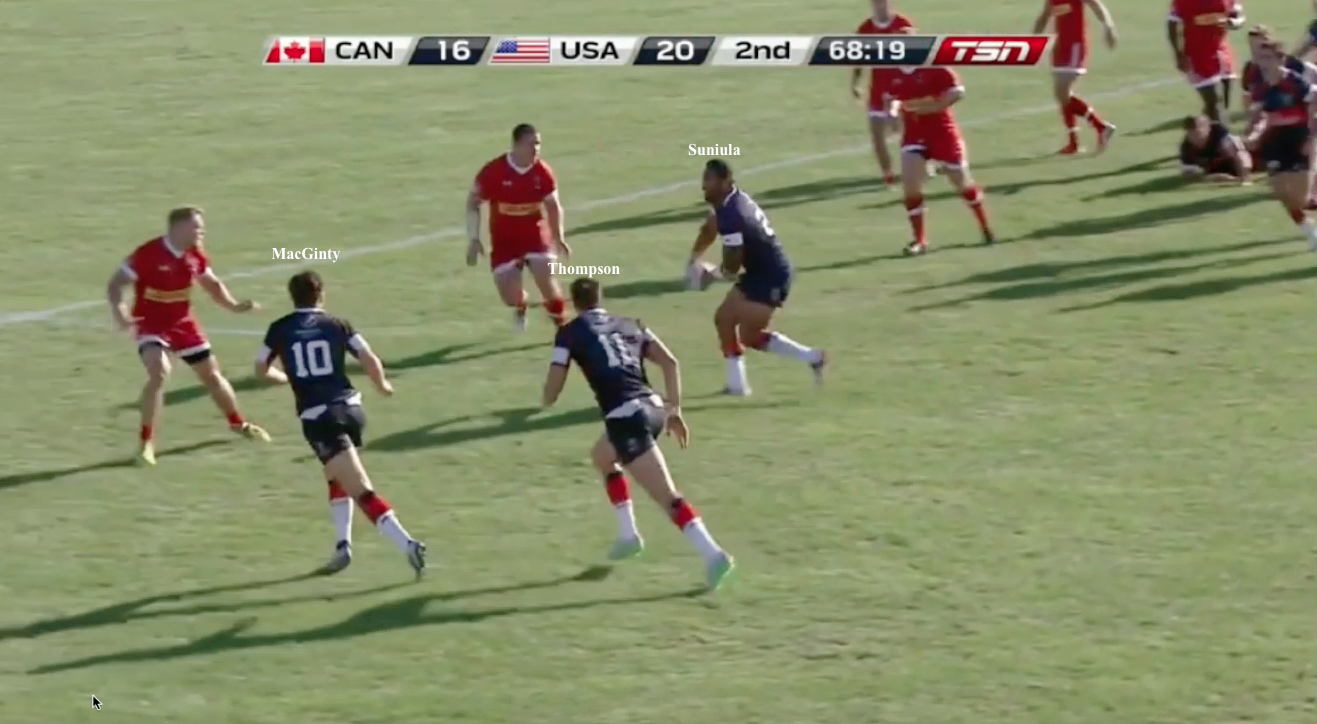 Andrew Suniula scored the try, but Wyles deserves lots of the credit for that score. He made two breaks in this sequence. After the second Wyles’ break, the American attackers weren’t scrambling to get into position because they’d already put themselves in the right position through a good kick-chase.
Andrew Suniula scored the try, but Wyles deserves lots of the credit for that score. He made two breaks in this sequence. After the second Wyles’ break, the American attackers weren’t scrambling to get into position because they’d already put themselves in the right position through a good kick-chase.
The try from Petri was the result of more sustained pressure. From a penalty, the Eagles kicked to touch and won the lineout cleanly. When the lineout stalled, Petri went for a little run, threw a dummy, and went over. As far as I can tell, this was the only run Petri took during the game from the base of a ruck/maul/scrum/lineout.
To finish the game, Cameron Dolan took advantage of some Canadian desperation and predictability, intercepting a pass that was slow in being delivered by a tired forward.
Still, Dolan has a knack for this kind of try (scored an intercept try against the Maori) and the pace to finish when he gets the ball.
5 tries for the match. Each ended up looking pretty simple because of the work done in the lead up.
The Eagles’ Attack
From a restart, when Taylor Paris ran away from Blaine Scully (smart move) the Canadians had a chance to move the ball wide, but instead, the move ended with a lineout to the Eagles. The lineout was won cleanly, but Petri knocked-on. Canada scrum. Under pressure, the USA win a turnover.
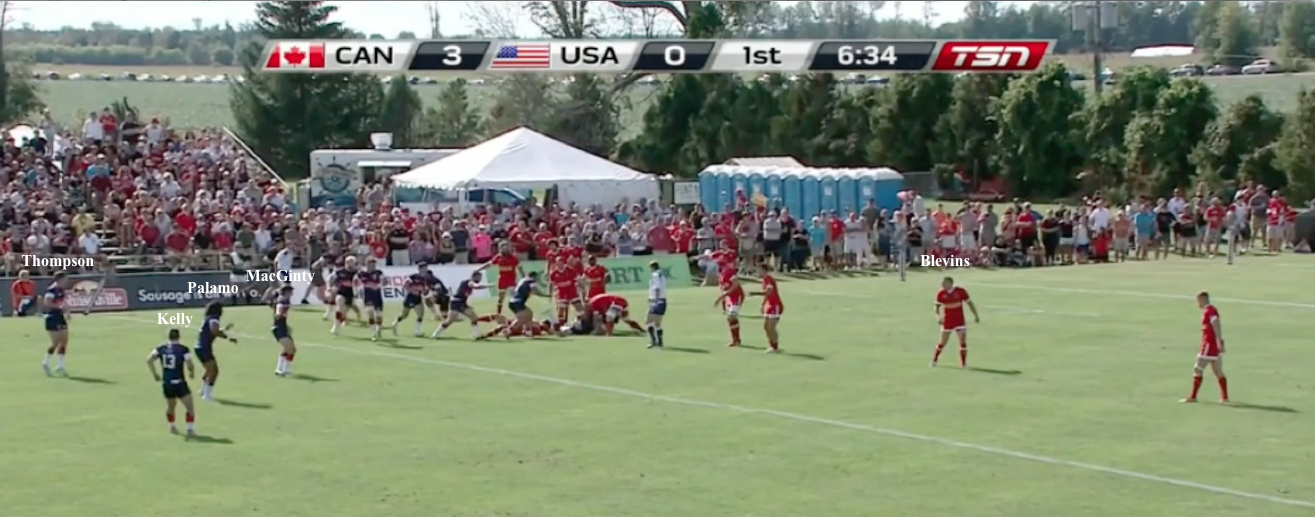 Turnover ball inside 22 meters! In the picture above, you can see Blevins, the Canadian defender who will end up making the next tackle.
Turnover ball inside 22 meters! In the picture above, you can see Blevins, the Canadian defender who will end up making the next tackle.
Thretton Palamo runs a tight line, which makes sense, but Brett Thompson also runs a line that is pretty tight.
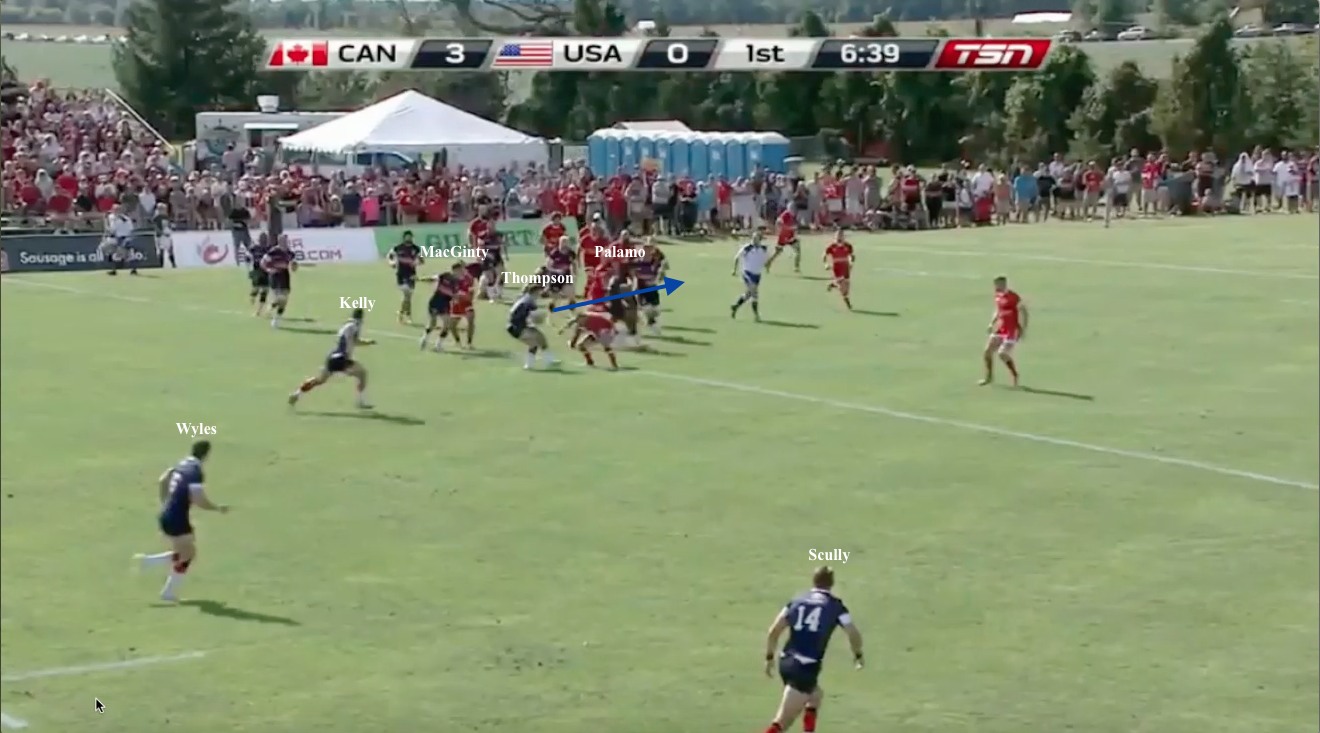 In the picture above, Thompson has just received the pass from MacGinty and is about to be tackled by Blevins. Seamus Kelly, Wyles, and Scully are all outside of Thompson. If Thompson’s line is wider, or if he receives the ball at a steeper angle (giving him more room and time to pass) the Eagles have a real chance here.
In the picture above, Thompson has just received the pass from MacGinty and is about to be tackled by Blevins. Seamus Kelly, Wyles, and Scully are all outside of Thompson. If Thompson’s line is wider, or if he receives the ball at a steeper angle (giving him more room and time to pass) the Eagles have a real chance here.
Instead, after the Durutalo crash, the defense has a chance to regroup and the first USA trip inside the 22 ends with a knock on. A real opportunity missed here.
From a lineout just inside their own half, the Eagles showed real danger in attack.
Dolan wins the ball and delivers it cleanly to Petri who makes a decent pass to MacGinty. MacGinty moves the ball on to Thretton Palamo. The most important part of the move is the offload that Palamo makes. He has two options: Durutalo on the left and Scully on the right. The pass puts Scully into space and the net result is a penalty to the Eagles from a kickable position. MacGinty missed. Still – clean ball from the set piece resulting is a good chance for points.
From the next lineout, Palamo just about makes it over the gain line, but in the next phase all support runners but one look to come inside, so the Canadian defender can sell out and whallop Wyles when the pass goes his way. Like the chance inside the 22 above, MacGinty needs to make a better decision, but the runners need to give better options.
In the last quarter of the game, the Eagles turn the ball over inside the Canadian 22. That hurts.
But Wyles is back there to field the clearing kick from Canada and buy a few seconds for the Eagles to recover. The problem? Look at the next gif and see if you can spot the urgency.
Sure, they are winning. Sure, they have reasons to be gassed. Sure, Peterson and Titi Lamositele, two of the guys walking, are about to be subbed off. But too many Eagles are slow to get into position to be useful. This sequence looks like a different team from the one in the lead up to Suniula’s try.
MacGinty, soon after this clip ends, kicks the ball directly into touch. He has to kick, though, and he pretty much has to find touch because any kind of counter attack is likely to find some space, so he can’t be criticized too much for the ball flying one meter too far.
Defensive Concerns
Early in the match, a Canadian handling error prevented them from running from deep. But they had another chance not much later, and this one they took.
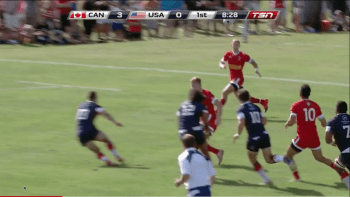 From the scrum, the USA 10, 12, and 13 were all quite narrow and the Canadians are able to get around them. In the picture, you can see 4 American defenders bunched tight, almost daring the Canadians to run around them. And they do. The result is Wyles calling for a mark inside the opposite 22. From a Canadian perspective, that has to be seen as successful execution. From the scrum to the next lineout, which followed the American clearing kick to touch after the mark was given, the Canadians gained about 43 meters in territory.
From the scrum, the USA 10, 12, and 13 were all quite narrow and the Canadians are able to get around them. In the picture, you can see 4 American defenders bunched tight, almost daring the Canadians to run around them. And they do. The result is Wyles calling for a mark inside the opposite 22. From a Canadian perspective, that has to be seen as successful execution. From the scrum to the next lineout, which followed the American clearing kick to touch after the mark was given, the Canadians gained about 43 meters in territory.
Later, from a Canada scrum near center field the US centers are again really narrow.
Fullback Harry Jones gets around Seamus Kelly and then it is 2 on 1. This leads to good field position for drop goal. It is 6-0 to Canada at this point.
On attack in the second half, Canada make a poor pass.
 This one bounces to John Moonlight, forcing him to turn around to pick it up. The Eagles have the numbers coming across in defense. However, the communication is not there.
This one bounces to John Moonlight, forcing him to turn around to pick it up. The Eagles have the numbers coming across in defense. However, the communication is not there.
Dolan and Thompson push up, with Thompson reeling in his aggression so he stays in line with Dolan. Peterson comes up pretty quickly to join them. When Moonlight steps back, it looks to be into a hole created by Durutalo trying to get across to cover on the wing rather than fill the closer gap.
By the direction Durutalo is heading in in the picture above, you can tell he was pushing wide, behind Peterson and Dolan, instead of staying on Peterson’s shoulder and working as a line. Moonlight is quick, recognizes where the hole is, and takes off.
In terms of the Eagles’ defense in the lead up to Canadian tries, The try scored by Taylor Paris was aided by questionable defensive decision making. For the Blevins try, it was execution rather than decision making: 3 defenders had a shot at Blevins before he went over.
Exit Strategy:
For the Eagles, Exit Strategy is closely linked to defense because over the last few years they have put themselves under a lot of pressure from failed exits. From the first two restarts, the Canadians are able to stay organized and ready for the clearing kick from MacGinty. Canadian errors are what relieved pressure, not anything the Eagles did particularly well.
That kind of organization by Canada might be harder if Samu Manoa is receiving the ball instead of Barrett. Dare I suggest that in this area, the Eagles might specifically miss Todd Clever? I think I dare.
However, there were some good things. On the third restart, Barrett again catches the kick. However, he does a little better in the contact situation. Peterson, surely recognizing that Canada do not want to contest the ruck, enters the ruck-area, but then snatches the ball up and makes a good run before off loading to Dolan. That is the kind of in-game improvement that the Eagles need.
The next restart saw Barrett pass directly to MacGinty, instead of taking the tackle, who kicked to touch. Canada took the lineout quickly. After that, Canada switched their restart strategy.
From a scrum at their defensive 22, the Eagles move the ball with purpose. Here is the setup from the scrum. The ball is won cleanly and the ball goes from Petri to MacGinty.
In addition to the option to kick from hand, MacGinty has Palamo and Wyles as options.
 Wyles has Kelly ready to chase the kick or take the pass.
Wyles has Kelly ready to chase the kick or take the pass.
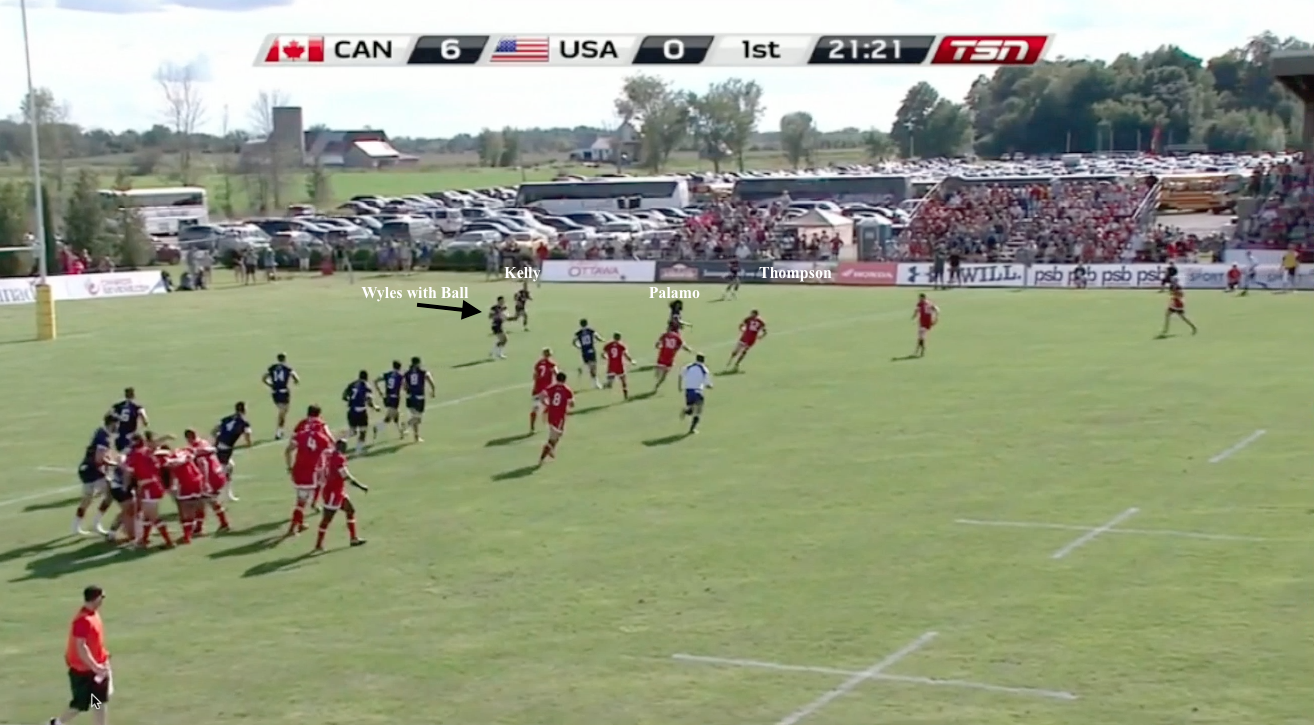 Kelly has Thompson outside him.
Kelly has Thompson outside him.
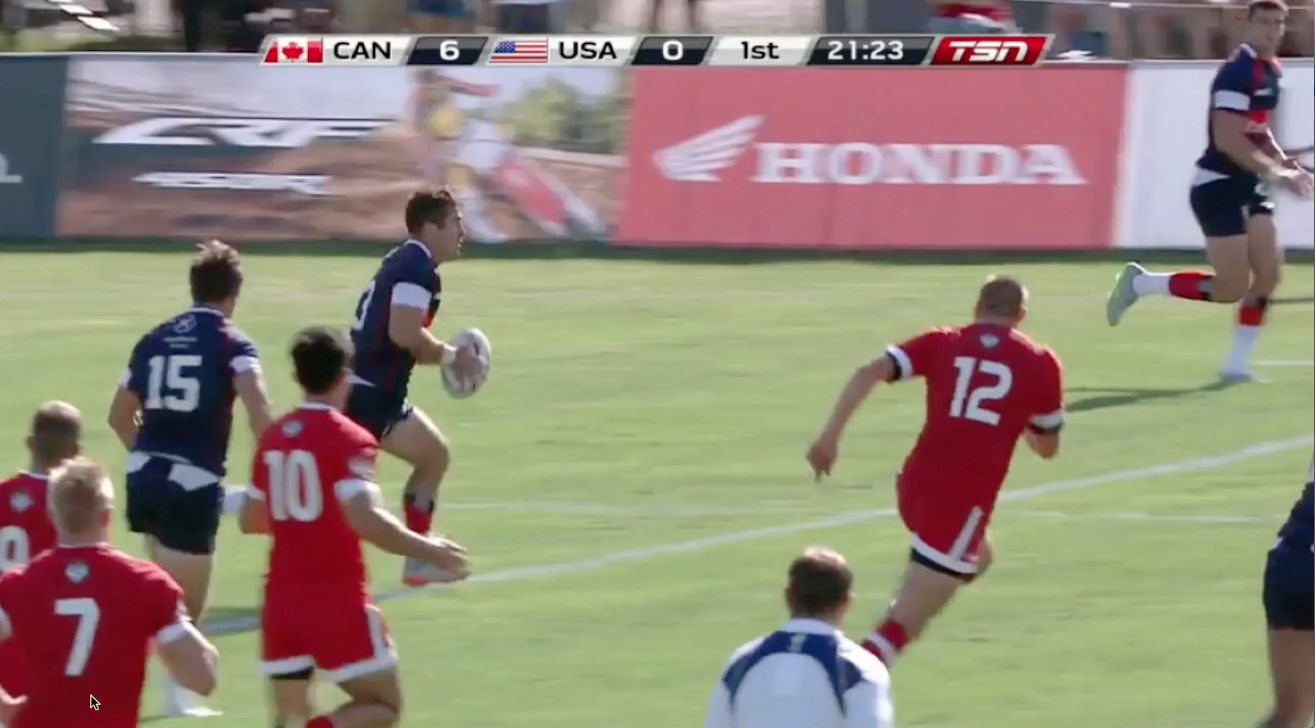 Nothing comes of this move, but the Eagles look organized and a move like this forces defenders to think instead of just sitting back and waiting for the kick.
Nothing comes of this move, but the Eagles look organized and a move like this forces defenders to think instead of just sitting back and waiting for the kick.
Restarts, Scrums, and Lineouts
The Eagles did not perform particularly well fielding Canada’s restarts. When Canada adjusted their kicks, stopped kicking to Barrett, the Eagles did not adjust well.
On their own restarts, the Eagles continue to use Scully well. He seems as good on restarts as any winger in the world right now, whether in contesting the ball in the air or making an immediate tackle on the kick-receiver.
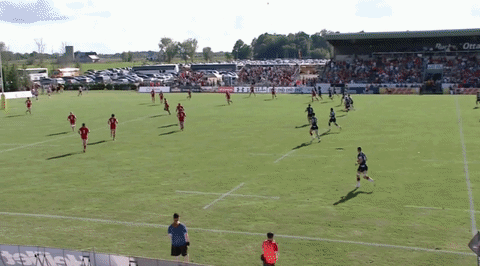
That just never gets old.
Both teams will be pleased enough with their attacking scrums and lineouts. I tried my best to get this interactive map of scrums and lineouts from the match embedded, but a link will have to do for now. You can sort by type of event (scrum or lineout) and by attacking team.
That’s it… Feel free to comment below, look for and “Like” our Facebook Rugby Wrap Up Page and follow us on Twitter@: RugbyWrapUp, Jake Frechette, Junoir Blaber, James Harrington, Jamie Wall, Nick Hall, DJ Eberle, Scheenagh Harrington, Jamie Loyd, Cody Kuxmann, Karen Ritter, Audrey Youn, Akweley Okine, Rocky Brown and Declan Yeats, respectively.


